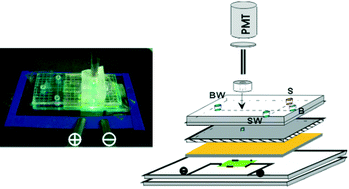A microfluidic device using a green organic light emitting diode as an integrated excitation source
Abstract
A simply fabricated microfluidic device using a green organic light emitting diode (OLED) and thin film interference filter as integrated excitation source is presented and applied to fluorescence detection of proteins. A layer-by-layer compact system consisting of glass/PDMS microchip, pinhole, excitation filter and OLED is designed and equipped with a coaxial optical fiber and for fluorescence detection a 300 µm thick excitation filter is employed for eliminating nearly 80% of the unwanted light emitted by OLEDs which has overlaped with the fluorescence spectrum of the dyes. The distance between OLED illuminant and microchannels is limited to ∼1 mm for sensitive detection. The achieved fluorescence signal of 300 µM Rhodamine 6G is about 13 times as high as that without the excitation filter and 3.5 times the result of a perpendicular detection structure. This system has been used for fluorescence detection of Rhodamine 6G, Alexa 532 and BSA conjugates in 4% linear polyacrymide (LPA) buffer (in 1 × TBE, pH 8.3) and 1.4 fmol and 35 fmol mass detection limits at 0.7 nl injection volume for Alexa and Rhodamine dye have been obtained, respectively.


 Please wait while we load your content...
Please wait while we load your content...